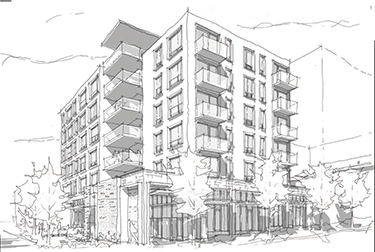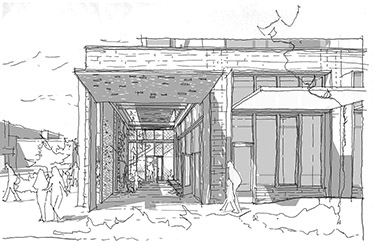|
Subscribe / Renew |
|
|
Contact Us |
|
| ► Subscribe to our Free Weekly Newsletter | |
| home | Welcome, sign in or click here to subscribe. | login |
Environment
| |
 |
March 24, 2016
Developers who try to go green find money stands in their way
Weber Thompson

Swain
|
The building industry is again under scrutiny following the adoption of the legally binding Paris climate conference agreement, which limits average global temperature increases to less than 2 degrees Celsius.
The good news is we are entering a period of great opportunity for smart design and investment.
Although there is still work to do, we have taken the first steps to getting there. The ecological challenges have been understood, and we’ve acknowledged that we have the ability to solve the problems.
Environmental revolution
Energy is a major focus, presenting an opportunity for improvement in every building project. The economics are simple and scalable: by reducing buildings’ energy demand, we save money in the operating costs.
But wait, there’s more! By reducing demand for energy (through more energy-efficient buildings), the cost and demand for primary energy resources also declines — in today’s energy grid, these are largely oil and coal reserves.
In addition, through investments in renewable energy (solar and wind), we have an opportunity to break our addiction to fossil fuels, eliminating the need for further resource extraction and exploration in environmentally sensitive areas. We saw this locally with Shell’s recent decision to abandon exploration of oil reserves in Alaska as a result of the drop in barrel price of crude oil.
Without increased demand, proposed new power plants become unnecessary. Economically, this frees up capital for reinvestment in sustainability initiatives and incentives.
The potential is compelling. It is potentially the foundation towards a global environmental revolution, advancing us beyond the industrial age and leaving something nice for our kids. It may sound a bit like a pipe dream, but we’ve seen pockets of small-scale success all around the country and the world.
One example is the intense goal of the net-zero building, introduced by the Living Building Institute and the Living Building Challenge. In Seattle, we’ve seen the Bullitt Foundation actually achieve this net-zero energy goal — a lofty achievement and a great case study to understand one path of success.
But with lofty goals come lofty costs, limiting the impact on the industry as a whole. If the success achieved is not repeatable or scalable, the overall contribution is diminished. This is the cycle we have found ourselves in today: a few gems and glimpses of the potential, but with the vast majority achieving more mediocre targets, largely due to the economics.
To get to net-zero as an industry, we clearly need a stepping stone. That could very well be the passive house model.
Focus on efficiency
In the residential sector, a growing number of single-family builders have been proving the viability of targeting energy efficiency for more than 25 years.
“Passive house” refers to a building strategy that focuses on superinsulated, airtight building envelopes, and incorporation of energy-efficient heat-recovery technology in the mechanical equipment.
The resulting buildings are both energy-efficient and comfortable — equally important to any sustainability strategy. Also important, the strategies are not limited to location, use or building type — they can be applied to any building across any sector.
To expand the knowledge of these building principles, the Passive House Institute and a U.S. branch of the organization (PHIUS) were created. They provide a certification process to recognize success, and are a resource of proven design strategies.
This largely grassroots organization has historically focused on single-family projects, but the multifamily and commercial development world is taking a hard look at these strategies to achieve the same level of success. (It should be noted that unlike other certification programs — Living Building, LEED and Built Green, for example — passive house focuses primarily on energy.)
At the Passive House Northwest Conference in Portland earlier this month, the first major-scale projects were presented, demonstrating both the successful integration of these energy-efficient strategies, but also the economic shortfall still challenging massive adoption across the industry.
The Cornell Tech residential tower in New York is a 26-story, 350-unit high-rise under construction that will be a long-term hold for an institutional owner with deep pockets. The Second and Delaware project in Kansas City is also a long-term hold, but for a market-rate developer. To pencil, they have incorporated a few creative funding mechanisms, including a loan from the U.S. Department of Housing and Urban Development and an integrated project delivery/profit-sharing-contracted construction team.
A technology premium
In Seattle, architects Weber Thompson, builder Cascade Built and developer Barrientos LLC are proposing a mid-rise multifamily project targeting passive house-level performance goals at 1300 E. Pike St. on Capitol Hill.
This small infill project of less than 50 units largely relies on its walkable, urban location in the Pike-Pine Urban Village to provide the amenity package for residents. The project incorporates interactive approaches to energy savings by relying on tenants to interact with the building differently, with features like operable exterior window shades, and variable refrigerant flow or possibly ground source energy-efficient cooling systems, rather than simple yet energy-intensive air-conditioning units.
Currently the necessary technologies are showing a 6 to 7 percent premium over costs of standard construction. To make it pencil, the projects are pursuing any available incentive, but those opportunities are limited.
Developers will do their best, but may fall short of the meeting the certification standards — an all-too-common occurrence in our industry, and another marker of the gap between the successes achieved and the data recorded and referenced.
We have recognized the core issue. We’ve developed the technologies and knowledge base to succeed. The final piece to make it reality are more incentive programs that help reduce first costs.
Jurisdictions need to recognize that buildings designed to meet these certifications provide long-term benefits to the community. Within these incentives, the economic sustainability of these buildings could be within reach.
Aaron Swain is an associate at Weber Thompson working in the mid-rise, multifamily design studio.
Other Stories:
- Big-box store gets a second life after a green makeover
- ‘Passive house’ design can make housing more affordable
- Weyerhaeuser’s new headquarters will show off its wood products
- Building operators add energy management to their repertoire
- Ballard fire station goes from energy hog to energy heaven
- South Lake Union’s ‘swale on Yale' is getting set to grow
- What is embodied carbon and why should we care?
- How sharing sit-stand desks will help Antioch be smaller and greener




